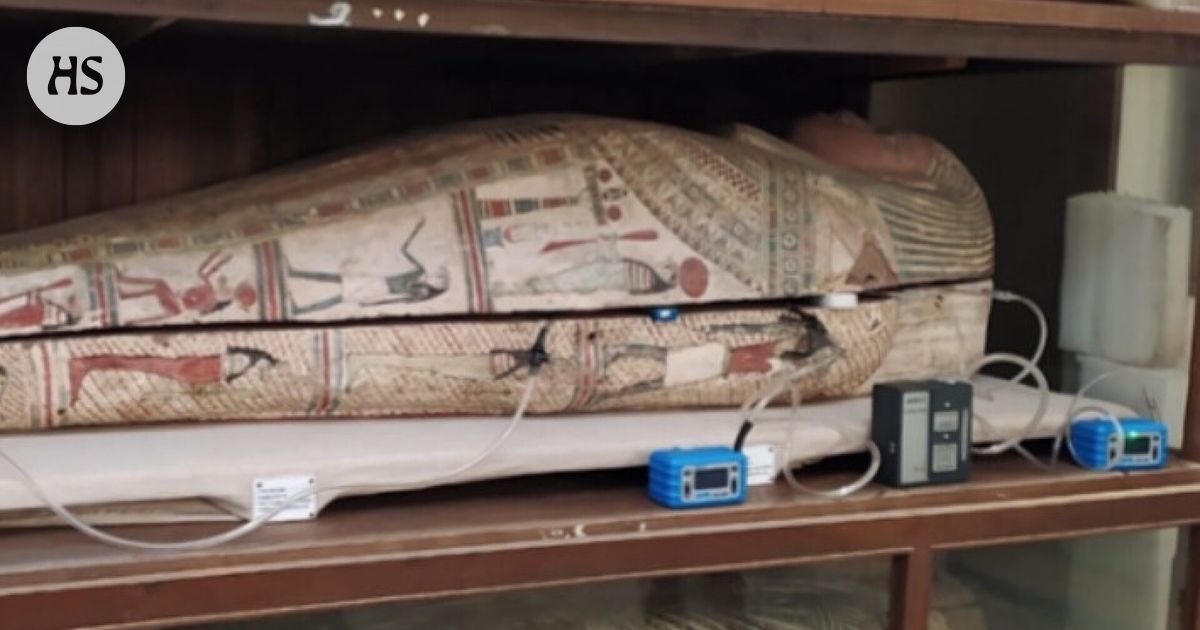The abstract is made by artificial intelligence and checked by man.
For the first time, researchers smelled the ancient Egyptian mummies systematically.
The international group used both human senses and electronic research equipment to study odors and compounds.
The aim was to identify preservative chemicals, molds, bacteria and microbes in general.
Woody. Spicy. Sweet. These descriptive words came to mind by the smells as they sniffed mummies from the ancient Egyptian times. However, the mummy’s odor world was also defined in words or even moldy.
According to a recent study, mummy odors were first investigated by systematic and versatile methods. Human senses and modern electrical senses were used.
Moomins were smelled by an international group with researchers from two universities, Slovenia University of Ljubljana and Britain from University College London.
The nine mummies under investigation were Cairo in the Egyptian capital In the Egyptian museum. The study was published Journal of the American Chemical Society in the science magazine.
Target It was not just to smell the mummies in his mind, but to look for smellful chemical signs of chemicals and ways in which the Egyptians captured their dead. At the same time, tips on how museums have kept mummies.
Chemical analysis can help to safeguard the work of museum conservators so that they are not accidentally exposed to harmful substances. Safeguarding the remains of the subject was also an important goal.
In the future announcement According to the museums, museums could even create the mummy’s smell world to smell. The justification could be the reminder of the study that the past is present to us as odorless.
Odors tell about the molecules that are excreted from the substance to the air. Scientists used gas chromatography and mass spectrometry to measure and define chemicals that were excreted in the mummies. They were associated with odors.
Chemicals secreted by mummies were sniffed by a group of trained sniffers. There were three women and five men in the group, aged 25-50. They had to define, among other things, the intensity and pleasure of the odors.
There were several definitions, but woody, spicy and sweet were most commonly highlighted. For example, the smells, lemon and flower -like smell or scent, also recognized the sniffers.
The researchers had to consider whether the chemicals observed by the devices were secreted from the substances used for conservation or the pests of pests used in museums, which may be odorless. The smells, on the other hand, may have been due to mummy decay due to molds, bacteria and other micro -organisms.
However, the smell of mummies turned out to be a way to examine them chemically without having to interfere with valuable remains.
Odors According to the researchers, they were important to the ancient Egyptian Palsamiiji, and pleasant scents were associated with spiritual purity and deities. Similarly, bad odors were associated with the deterioration and corruption of the human body.
According to the announcement, body handlers used, for example, the resin and oils of conifers, for example, from a cedar. They used Mirham and the oliban resin, or Frankinsens, aromatic resin. There were quite a few other substances, such as spices, herbs and flowers.
Body Treatment to take time was important for transition to post -death life. There were detailed rituals for balms, recalls professor Ali Abdelhalim From the Egyptian museum in the press release.
The means evolved over time, so identifying them with odors also gives clues about the era and position of the mummified person.
According to the study, the oldest means about 7,000 years ago was to leave the body in the hot dry desert to naturally become mummy.
According to the study, the balms continued to develop maybe between 2700 and 2200 before the beginning of the era, as the use of chemicals was increasingly controlled and the brain and internal organs were removed from the deceased. The skill was at its peak during the new kingdom about 1670-1100 before the beginning of the era and ended only when the Arabs conquered the Egypt in the 6th century.

Elkoraya Livee
HD quality streams | Yacine TV
Stream live sports
Yasino Tv
Yassien
anoud mahmoud
Stream live sport Matches
Yacine App
designedbytrisha
bldymalice
ayeecash
sauvmy problems
ayoecho
bloodsmile
golden-luke
luisandclark
sacred-holly
Financing Solutions for Your Clinic Business
Transforming Homes in Dubai: Residential Landscaping and Luxury Kitchen Designs – English Mastery Pro
The Ultimate Guide to Choosing the Right Landscaping Company – VyvyManga
Transform Your Backyard with Dubai’s Top Pool & Landscape Experts!
Discover How Pool And Landscape Companies Revitalize Homes – InShot Spot
Breakfast Coffee
Les 40 ans de l'Acepp : Henrygunsforsale
Khí Nén Tuấn Cường
Làm Đẹp Tại Nhà | – Shop mỹ phẩm 247 – Sức Khỏe & Làm Đẹp
Máy nghe trộm, Máy nghe lén, Camera ngụy trang, camera quay lén
Phụ Kiện Kính – Phụ Kiện Kính
Cơ Khí Minh Quốc – Chuyên Gia Công Cơ Khí tại Tp. HCM
Thiết Bị Công Nghiệp Nhà Xưởng Nam Việt Nhật